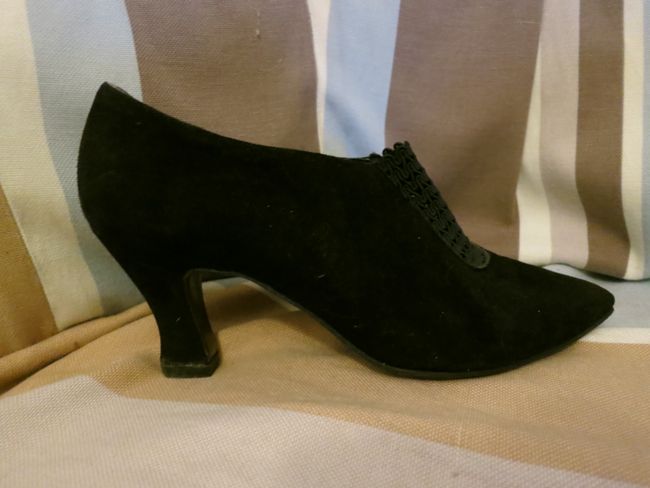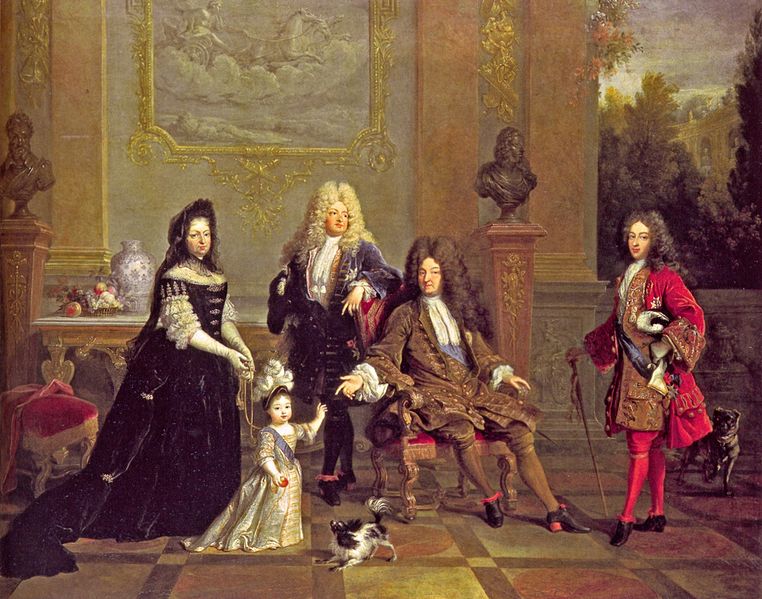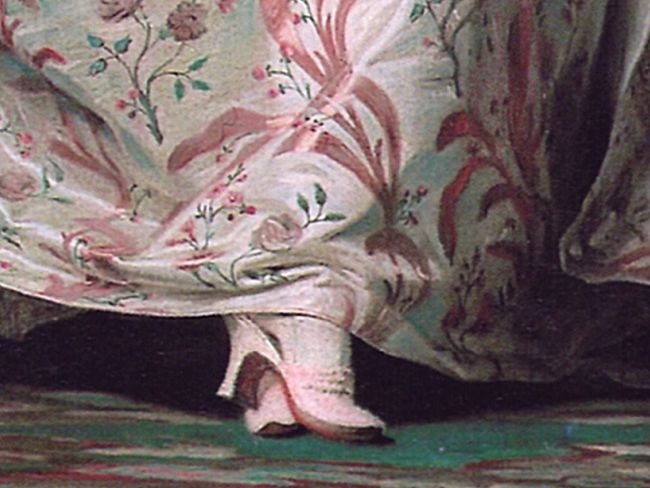For my Historical Sew Fortnightly ‘The Politics of Fashion’ challenge I present a carry-on from my Art submissions. I’ve knocked off another little bit of Manet’s Nana’s outfit by making high heeled 1877 evening shoes.

Like Nana’s shoes, mine feature very high Louis heels, a black velvet or suede ground (mine are faux suede), and gold decorations on the toes – I went for gold lace with gold beading.

I made my shoes by taking a pair of 1990s shoes that had the right basic silhouette, and (most importantly) the right heel: a high Louis heel.

Unfortunately, they were cut far too high in the foot, so I had to cut them down.


Then I bound the edges (an endeavor that required pliers to pull the needles through, bent one and broke two) where I had cut them.

Next, it was time for the lace. Unfortunately, I didn’t have any suitable gold lace in the stash because I de-stashed my 1990s gold bridal lace bits because (duh) they were 1990s gold bridal lace bits, and when was I ever going to find a reason to use them? (for this, apparently). So I had to make-do. I rummaged around in my lace, and found these cute handkerchief corner pieces:

As you have noticed, they are white. So, trusty Elmer’s metallic opaque paint markers in gold to the rescue. FOUR HOURS of painstakingly painting bits of lace gold later (at hour two and a half I realised I could have just spent 10 minutes popping to the hardware store and buying gold spray paint, and then another 10 spraying them (Plus the flattering bonus that I still get carded when I buy spray paint) and I would have got the same result), I had beautiful gold lace – much more restrained and antique than the disdained 90s lace would have been.

Then I sewed the lace to the shoes (more pliers, but I managed not to break any needles), layering two handkerchief corners over each other on each shoe.

Then I beaded (pliers), using antique gold beads, half of which wouldn’t go through any needle that was remotely strong enough to go through the shoes, because that’s the kind of project this was.

But don’t they look pretty?

So how are my shoes related to politics? It’s all about the heels: Louis heels.
A Louis heel is a moderately high heel (short Louis heels are called baby Louis heels, though this term wasn’t used until at least the 1950s) that curves in at the midpoint of the heel, and flares out again at the heel tip. The sole of a Louis heeled shoe extends down the front breast of the heel, rather than stopping where the heel meets the sole, as in other heel styles.
Here is a pair of 1870s-80s shoes with Louis heels:
And a pair without:
A distinction is sometimes made between the construction of the Louis heel, with the extended sole, and the style of a Louis heel, with the curved silhouette. If you wish to make a distinction between the construction and the style, the former is called a Louis heel, and the latter a Louis XV heel/shoe, or a Pompadour heel/shoe.

Louis heels on mid-18th century shoes, collection of the Honolulu Museum of Art, thedreamstress.com
Louis heels are clearly named after a French monarch, but which one is not clear. A number of modern sources point to Louis XIV – the Sun King. After all, he famously engaged in a battle with his brother for who could wear the higher, more extravagant shoe, he even more famously instituted the tradition of red high heeled shoes that only those with royal dispensation could wear, and finally, he was the patron of the first shoe superstar: Nicolas Lestage. The Sun King loved his shoes, and dozens of portraits show his showing off his elegant calves and fancy footwear. However, these portraits clearly show that Louis XIV wasn’t wearing Louis heels:

Louis XIV and heirs with the royal governess, Formerly attributed to Nicolas de Largillière, now unknown, circa 1710
Even for women, Louis heels only come into fashion in the last decades of his reign.
So what about his successor, Louis XV? Here we find success. Louis XV is the term applied to the style of shoes in the 19th century (it is not until 1894 that a NZ newspaper mentions Louis heels, whereas Louis XV heels are mentioned frequently from the 1870s onwards) , and the vast majority of shoes from Louis XV’s reign feature Louis heels.

Shoes, 1732—59, British, silk, leather, metal, Metropolitan Museum of Art
The attribution is made certain when we consider that Louis heels are also called ‘Pompadour’ heels, after Louis XV’s most famous, and most sartorially elegant, mistress, who did indeed wear Louis heels, usually as mules.

Madame de Pompadour, by Maurice Quentin de La Tour, 1755, Louvre Museum (detail)
Towards the end of the 18th century Louis heels began to be replaced by other styles of heels, such as Italian heels, and much lower heels. Louis heels fell out of favour entirely during the French revolution, when high heels were seen as a symbol of aristocratic decadence. Even during the Revolution France was the international style leader, so high Louis heels became demode across the world.
Louis heels remained unfashionable throughout the first half of the 19th century. That all changed with Empress Eugenie and the Second Empire in France. Napoleon III and Eugenie were seen as a glamourous couple, the Second Empire saw a return to decadence, and Eugenie was infatuated with Marie Antoinette and the 18th century. She had her rooms decorated in the style of Marie Antoinette, dressed as the doomed queen for fancy dress balls and official portraits, and inspired Worth to incorporate elements of 18th century fashion into his dress designs.

Empress Eugenie as Marie-Antoinette, 1854, Franz Xaver Winterhalter
Under Eugenie, everything 18th century was fashionable again, including Louis heels. For 50 years shoes had either been flat, or had practical low, stacked heels. Suddenly, in the 1860s, heel heights grew, and the seductive curves of Louis heels were all the rage. At first the English speaking world simply called them French heels, but in the 1870s the name Louis heels, or Louis XV heels, rose to the fore and has remained the most commonly used term for them ever since.
Louis heels were seen as the perfect symbol of the Second Empire: elegant, decadent, but ultimately unstable and ill-conceived. When the Empire collapsed in 1870, Louis heels fell out of favour slightly, especially for daywear, but were soon back in fashion for the remainder of the 19th century (and much of the early 20th century).
The more practical decried the return of high heels, and saw the Louis heel as unhealthy and dangerous. An 1899 columnist sighed “no matter if they are injurious, the fact that the foot looks distinctly smaller with them does away with all discussion. So the enchantment of the Louis heel, well curved under, must be answerable to all anticipated injury.”
Louis heels are also the perfect symbol for Nana: decadent and dangerous. It’s no surprise that Manet depicts her in a pair with extremely high heels, adding to all the other visual clues in the painting that indicate that she is not a lady of impeccable morality. From her saucy blue corset, to her unsteady footwear, Nana represents temptation, immorality, decadence. Manet could not have known that three years later Zola would use her as a literal symbol of the Second Empire, a political regime with far less staying power than the footwear it returned to fashion.

The Challenge: #11 — The Politics of Fashion
Inspiration: Manet’s Nana, 1877
Fabric: None.
Pattern: None
Year: 1875-85
Notions: Early 90s shoes ($5 at an op shop), 4x lace handkerchief motifs (50 cents each at an op shop), bias tape (stash), linen thread (stash), antique gold beads (inherited).
How historically accurate is it? I’ve followed the aesthetic of 1870s shoes as much as possible, and researched accurate techniques and styles, but there is only so much you can do working with modern shoes (especially when they aren’t even real leather).
Hours to complete: 7 hours
First worn: Not yet, I’m waiting to assemble everything so I can do a Nana photoshoot!
Sources:
Bossan, Marie-Josèphe. Art of the Shoe. New York: Parkstone Press Ltd. 2011
Cumming, Valerie and Cunnington, C.W.; Cunnington, P.E, The Dictionary of Fashion History (Rev., updated ed.). Oxford: Berg Publishers. 2010
DeJean, Joan. The Essence of Style: How the French Invented High Fashion, Fine Food, Chic Cafes, Style, Sophistication, and Glamour. New York: Simon & Schuster. 2005
Lee, Landis R. They Wore What? Style and Social Roles of Boots in Late 19th and Early 20th Centuries Nevada (Masters Thesis). University of Nevada. 2008
Lewandowski, Elizabeth J. The Complete Costume Dictionary. Plymouth, UK: Scarecrow Press. 2011
Severa, Joan L. Dressed for the Photographer: Ordinary Americans and Fashion, 1840-1900. Kent, Ohio: Kent State University Press. 1995
SaveSave




















They are lovely shoes, and will greatly enhance your Nana ensemble!
They’re gorgeous. You’ve really improved those shoes!
The shoes work really well! Can’t wait to see the whole ensemble.
Just a note: Louis heels are so comfortable to wear. The heels seem to be perfectly placed under the middle of the heel, so that walking is as natural as possible, and the flare at the bottom makes them so much more stable than pointy heels. Go, Louis heels!
When I was a teenager, my first pair of ‘heels’ were called ‘Baby Louis heels’. I thought I was the smartest thing!
I agree that they are awesome! I suppose after almost completely flat shoes they did seem impractical to the Victorians, but then you compare them to today’s stilettos and stacked heels…
I was just thinking that I ought to edit the post to add that very short Louis heels are called ‘Baby Louis heels!’ So much information!
🙂
Alternative title: “High Heels and Broken Needles”
They turned out beautifully. It’s definitely an improvement on the original shoe. 😉 And I think the lace you got in the end is just perfect. It enhances the elegant curves of the shoes.
I can’t wait for your Nana photo shoot! “Louis heels” are called “Baroque heels” which seems to be inaccurate now that I’ve read your post…
I can’t wait either! Just one tiny bit to finish – there is always so much else to do though!
Is Baroque heels the German term? It’s not entirely inaccurate, as they first appear at the end of the Baroque era, so you could say they were ‘invented’ during the Baroque period. 🙂
What a lovely pair :). This style of heel has always been my favourite and it’s such a shame one can’t seem to find it more often in modern footwear.
Maybe next time you can spare yourself some trouble and plier work and do the beading before attaching the lace to the shoe. That’s how I would’ve done it, at least.
I did try that, but the lace was too open and loose to support the beadwork, so it had to be done after.
So in Louisa May Alcott’s Little Women, Meg is facing double trouble at the grand ball: a wide-skirted hem that’s too long and also newly stylish heels that are too high. “Don’t Tread On Me,” she says is her motto, to the delight of the young Union officers she’s flirting with–and she means it! Thanks for the additional information.